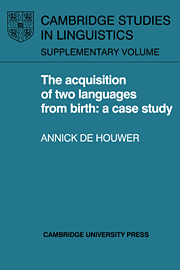
-
Select format
-
- Publisher:
- Cambridge University Press
- Publication date:
- August 2009
- June 1990
- ISBN:
- 9780511519789
- 9780521366526
- 9780521024358
- Dimensions:
- (228 x 152 mm)
- Weight & Pages:
- 0.756kg, 408 Pages
- Dimensions:
- (229 x 153 mm)
- Weight & Pages:
- 0.608kg, 408 Pages
You may already have access via personal or institutional login
Book description
This book deals with the question of how children exposed to two languages simultaneously from birth learn to speak those two languages. After a critical and comprehensive survey of most of the literature on the subject, the author concludes that empirically well-documented knowledge in this area is very scant indeed. The core of the book concerns a naturalistic study of a Dutch-English bilingual girl around the age of three. The study's main aim is to explore the nature of early bilingual morphosyntactic development. Detailed analyses of most aspects of this development show that a child who hears two separate languages spoken to her reflects this distinctness in the utterances she produces: each language is handled as a system in its own right. Furthermore, the young bilingual three-year-old greatly resembles her monolingual peers in either language. Both these findings, the author concludes, highlight the language-specific nature of the morphosyntactic development process. This book will interest linguists, psycholinguists, developmental psychologists, and child language specialists.
Contents
Metrics
Altmetric attention score
Full text views
Full text views help Loading metrics...
Loading metrics...
* Views captured on Cambridge Core between #date#. This data will be updated every 24 hours.
Usage data cannot currently be displayed.
Accessibility standard: Unknown
Why this information is here
This section outlines the accessibility features of this content - including support for screen readers, full keyboard navigation and high-contrast display options. This may not be relevant for you.
Accessibility Information
Accessibility compliance for the PDF of this book is currently unknown and may be updated in the future.


